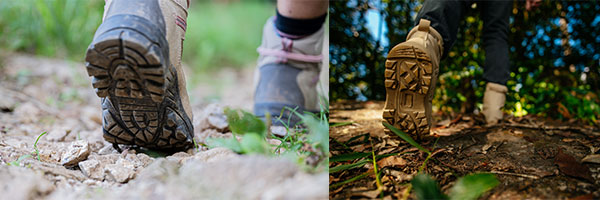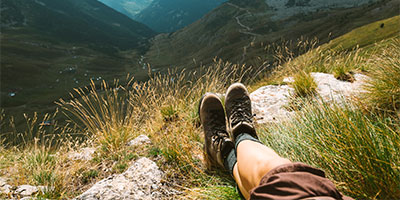30 Kas


1 Yorumlar
613 Görüntüleme
Yürüyüş İçin Bot Seçimi Nasıl Yapılmalıdır
Doğada yürümek zor bir aktivitedir. Özellikle doğru botların
seçilmesi çok önemlidir. Bu botların seçiminde nerede ve nasıl yürüyüş
yapacaksınız bunlarda önemli konulardır. Botlarınızla ayaklarınız uyum içinde
olmalıdır. Botlarınızı giydiğiniz zaman parmaklarınızı, ayağınızın arkasını
vurmamalı ve rahat hareket etmelisiniz. Bu botların çeşitlerini inceleyecek
olursak;
-Kısa Yürüyüş Botları
Esnek orta tabanlı alçak kesim modeller günlük yürüyüşler
için gayet iyi bir seçimdir. Yağmurlu havalarda tercih edilmemesi doğru bir
karar olacaktır ancak hafif ve rahat tarzıyla birçok kişi tercih etmektedir.
-Günlük Yürüyüş Botları
Orta ve yüksek kesimli modelleri vardır. Günlük yürüyüşlerde
ve kısa süreli outdoor aktivitelerinde kullanılabilir. Kolayca esnerler ve
ayağınıza uyum sağlarlar.
-Uzun Yürüyüş Botları
Kırsal bölgelerde yapılacak uzun seyahatler için uygun
botlardır. Üstünüzdeki ağır yükleri taşımak ve kullanıcıları rahat ettirmek
için tasarlanmışlardır. Özellikle ayak bileklerini saran yüksek kesimli olan
türleri, taşıyacağınız yükün ve ayak bileklerinize binecek ağırlığın
desteklenmesini sağlar. Hafif ve kısa botlara göre daha sert orta tabanları
vardır ve bunlar dayanıklı ve destekleyici bir yapıya sahiptirler. Parkur ve
arazi gibi yerlerde seyahat için tasarlanmışlardır.


Yürüyüş Botlarının Katmanları
Üst Katman: Kullanılan malzemeler botun ağırlık, nefes
alabilirlik, dayanıklılık ve su geçirmezlik gibi önemli noktalarını etkiler
buda botun kalitesini belirler.
Sırça deri ayakkabılar kullanıcılara mükemmel dayanıklılık,
aşınma direnci ve çok iyi su dayanıklılığı sunar. Uzun yolculuklar, ağır yükler
ve engebeli araziler için tasarlanırlar. Bu botlar diğer türlere göre hafif ve
nefes alabilir değildirler. Kesinlikle uzun bir yolculuk öncesi ayağınızın bota
alışması için birkaç kere giyilmelidir. Aksi takdirde ayağınızı rahatsız edebilir.
Naylon-parçalı deri harika nefes alabilirlik sunar hafif bir
bot yapısı oluşturabilmek için naylon veya deri karışımından üretilir. Daha
düşük maliyetli botlardır ancak suya ve aşınmaya karşı daha az dirençlidirler.
Şunu belirtmek gerekir bu botlarda genelde su geçirmez astarlar kullanılır.
Nubuk deriler parlatılmış sırça deridir. Suya, aşınmaya
karşı dayanıklıdır ve oldukça esnektir. Bu tip botlar ilk alındığı zaman uzun
yürüyüşler öncesi mutlaka giyilmelidir. Sentetik deri botlar yaygın olarak
piyasada mevcuttur. Deriden hafiftir, hızlı kuru ve daha ucuzdur. Ancak botun
dış tarafında fazla dikiş olması sebebiyle erken aşınmalar olabilir.
Orta Katman: Yastıklama sağlayan orta katman, ayakları
darbelere karşı korur ve botun sertliğini belirler. Sert botlar, kayalık ve
engebeli arazide uzun yürüyüşler için çok daha fazla konfor ve denge demektir.
Ayrıca kayalık ve ağaç kökleri gibi sert cisimleri hissetmenize engel olur ve
dış etkenlerden koruma sağlar. En yaygın orta taban malzemeleri EVA ve
poliüretandır.
EVA (Etilen Vinil Asetat) biraz daha rahat, hafif ve
ucuzdur. Orta katmandaki desteği ayarlamak için farklı yoğunluklarda
kullanılabilir. Poliüretan daha sert ve dayanıklıdır. Bu malzeme uzun
yürüyüş botlarında ve dağcılık botlarında kullanılır.
Orta tabana sağlamlık kazandırabilmek için 3-5 mm
kalınlığında uçlar (saplar), botun orta tabanı ile dış tabanı arasına
sıkıştırılmıştır. Plakalar ise ince ve yarı esnek eklerdir. Orta taban ile dış
taban arasına ve varsa gövdenin altına yerleştirilir. Ayakları dış etkenlere
karşı korur.
Alt Taban: Yürüyüş botlarının tabanlarında genellikle kauçuk
kullanılır. Sertliği artırmak için uzun yürüyüş ve dağcılık botlarında karbon
gibi katkı maddeleri eklenir ve sertlik derecesi artırılır. Sert dış tabanlar
dayanıklılığı artırır. Dağcılık ve yürüyüş botlarının alt tabanında daha kalın
ve derin girinti çıkıntılar vardır. Bu çıkıntılar yürüyüş esnasında çamurun
daha kolay şekilde dökülmesini sağlar. Topuk bölgesinin açıkça belirlenmiş
olması ise dik inişlerde kaymayı en aza indirir.
Kazasız, keyifli ve macera dolu bir yürüyüş dileriz…
Doğada yürümek zor bir aktivitedir. Özellikle doğru botların seçilmesi çok önemlidir. Bu botların seçiminde nerede ve nasıl yürüyüş yapacaksınız bunlarda önemli konulardır. Botlarınızla ayaklarınız uyum içinde olmalıdır. Botlarınızı giydiğiniz zaman parmaklarınızı, ayağınızın arkasını vurmamalı ve rahat hareket etmelisiniz. Bu botların çeşitlerini inceleyecek olursak;
-Kısa Yürüyüş Botları
Esnek orta tabanlı alçak kesim modeller günlük yürüyüşler için gayet iyi bir seçimdir. Yağmurlu havalarda tercih edilmemesi doğru bir karar olacaktır ancak hafif ve rahat tarzıyla birçok kişi tercih etmektedir.
-Günlük Yürüyüş Botları
Orta ve yüksek kesimli modelleri vardır. Günlük yürüyüşlerde ve kısa süreli outdoor aktivitelerinde kullanılabilir. Kolayca esnerler ve ayağınıza uyum sağlarlar.
-Uzun Yürüyüş Botları
Kırsal bölgelerde yapılacak uzun seyahatler için uygun botlardır. Üstünüzdeki ağır yükleri taşımak ve kullanıcıları rahat ettirmek için tasarlanmışlardır. Özellikle ayak bileklerini saran yüksek kesimli olan türleri, taşıyacağınız yükün ve ayak bileklerinize binecek ağırlığın desteklenmesini sağlar. Hafif ve kısa botlara göre daha sert orta tabanları vardır ve bunlar dayanıklı ve destekleyici bir yapıya sahiptirler. Parkur ve arazi gibi yerlerde seyahat için tasarlanmışlardır.


Yürüyüş Botlarının Katmanları
Üst Katman: Kullanılan malzemeler botun ağırlık, nefes alabilirlik, dayanıklılık ve su geçirmezlik gibi önemli noktalarını etkiler buda botun kalitesini belirler.
Sırça deri ayakkabılar kullanıcılara mükemmel dayanıklılık, aşınma direnci ve çok iyi su dayanıklılığı sunar. Uzun yolculuklar, ağır yükler ve engebeli araziler için tasarlanırlar. Bu botlar diğer türlere göre hafif ve nefes alabilir değildirler. Kesinlikle uzun bir yolculuk öncesi ayağınızın bota alışması için birkaç kere giyilmelidir. Aksi takdirde ayağınızı rahatsız edebilir.
Naylon-parçalı deri harika nefes alabilirlik sunar hafif bir bot yapısı oluşturabilmek için naylon veya deri karışımından üretilir. Daha düşük maliyetli botlardır ancak suya ve aşınmaya karşı daha az dirençlidirler. Şunu belirtmek gerekir bu botlarda genelde su geçirmez astarlar kullanılır.
Nubuk deriler parlatılmış sırça deridir. Suya, aşınmaya karşı dayanıklıdır ve oldukça esnektir. Bu tip botlar ilk alındığı zaman uzun yürüyüşler öncesi mutlaka giyilmelidir. Sentetik deri botlar yaygın olarak piyasada mevcuttur. Deriden hafiftir, hızlı kuru ve daha ucuzdur. Ancak botun dış tarafında fazla dikiş olması sebebiyle erken aşınmalar olabilir.
Orta Katman: Yastıklama sağlayan orta katman, ayakları darbelere karşı korur ve botun sertliğini belirler. Sert botlar, kayalık ve engebeli arazide uzun yürüyüşler için çok daha fazla konfor ve denge demektir. Ayrıca kayalık ve ağaç kökleri gibi sert cisimleri hissetmenize engel olur ve dış etkenlerden koruma sağlar. En yaygın orta taban malzemeleri EVA ve poliüretandır.
EVA (Etilen Vinil Asetat) biraz daha rahat, hafif ve ucuzdur. Orta katmandaki desteği ayarlamak için farklı yoğunluklarda kullanılabilir. Poliüretan daha sert ve dayanıklıdır. Bu malzeme uzun yürüyüş botlarında ve dağcılık botlarında kullanılır.
Orta tabana sağlamlık kazandırabilmek için 3-5 mm kalınlığında uçlar (saplar), botun orta tabanı ile dış tabanı arasına sıkıştırılmıştır. Plakalar ise ince ve yarı esnek eklerdir. Orta taban ile dış taban arasına ve varsa gövdenin altına yerleştirilir. Ayakları dış etkenlere karşı korur.
Alt Taban: Yürüyüş botlarının tabanlarında genellikle kauçuk kullanılır. Sertliği artırmak için uzun yürüyüş ve dağcılık botlarında karbon gibi katkı maddeleri eklenir ve sertlik derecesi artırılır. Sert dış tabanlar dayanıklılığı artırır. Dağcılık ve yürüyüş botlarının alt tabanında daha kalın ve derin girinti çıkıntılar vardır. Bu çıkıntılar yürüyüş esnasında çamurun daha kolay şekilde dökülmesini sağlar. Topuk bölgesinin açıkça belirlenmiş olması ise dik inişlerde kaymayı en aza indirir.
Kazasız, keyifli ve macera dolu bir yürüyüş dileriz…




1 Yorumlar
çok değerli bilgiler. teşekkürler, elinize sağlık.
Yorum Yap